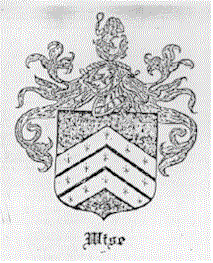|
   
 
Last Updated Feb 2001
  
WISE
COAT OF ARMS

Crest: The old crest of the Wise's of Sydenham, England, was a
mermaid proper. The arms, crest and motto of Devonshire, England,England Wise's were
granted John Wise of Sydenham in 1400. These are recorded by Henry St. George in his
" Visitation of Devonshire, 1620".
  

The arm are:
Arms: Sable, three chevronels ermine
Crest: A demi-lion rampant gules, guttee argent, holding in his paws
a regal mace
MOTTO: "Sapere aude" (Dare to be wise).
Lions (argent) Silver (English)
Lerk (argent) Silver (Scottish)
Tulips Red (Dutch)
  
This was from the book Col. John Wise of England and Virginia
(1617-1695)
(I kept the spelling the same, as it was in the book)
The significance of the three chevronels on the sable shield has ever
represented the fact that three great families of Wises rose into prominence in
Devonshire, these heraldic figures standing for the gables of three roofs, or separate
houses, from the same general stock. Whether the three families of Wise were those of Sir
John Wise of "Totness," Sir Thomas Wise of "Mount Wise" and
"Sydenham," and William Wise of "Cudleston," who were contemporaries
in the time of James I., and heads of the three branches sprung from James Wise of
"Sydenham" (Henry VIII), or whether, as heretofore suggested, the three families
were the ancient branches of Oliver, Sir John, and Henry, who were sons of Serlonius Wise
(1100-1200 A.D.), is not clear. It is probable, however, that the three families indicated
were the contemporary branches at the time the arms were granted.
We have seen that James Wise of "Sydenham" and Alicia
Dynham, daughter of John Dynham of Wortham, had four sons--John, Sir William, Sir Rychard,
and George.
The descendants of Sir William Wise, and his brother George, are not
known, Rychard Wise became Sir Rychard Wise of "Cudleston," who inserted a star
in the family arms. His son was John Wise of "Cudleston." Of his two sons, John
and William, there is no record of the elder, who was the legal heir and namesake of his
father. His brother William inherited the estate of "Cudleston," and it is
possible that John migrated to America in 1635. The descendants of William of
"Cudleston" became the Wises of "Gilsdon," who died out in the third
generation, of which Matthew Wise of "The Priory," Co. Warwick, who died in
1776, Henry Wise of "Hampton Court, who died in 1706, and John Wise of
"Brompton," their brother, were the male members.
The elder brother of Sir William, Sir Rychard, and George--John Wise
of "Sydenham"--married Alicia, daughter of John Harris of Hayne, Sergeant at
Law, and had issue: John Wise of "Totness," Nicholas, James, Charles, Erkenbold
or Arkenold, Thomas of "Sydenham," and five daughters--Elizabeth, Alice,
Dorothy, Mary, and Anne.
John Wise of "Totness," first son of John Wise and Alicia
Harris, married Emmota, daughter of Richard Vavasour of "Hazlewood," and had
issue: William Wise of "Totness," born 1560, died 1626; Samuel, Christopher, and
Henry. William of "Totness" married Friswida, and had two sons--John Wise of
"Totness," who died September 6, 1670, William, of whom nothing is know--and
three daughters. John Wise of "Totness" married Susannah, daughter of Samuel
Prestwood, and his son John Wise of "Totness," by his second wife, Dorothy
Brookings, perpetuated the line through a younger son, Samuel of "Totness" and
Barnstaple," from whom was descended the late Vice-Admiral Wise, of the British Navy,
and Maj. Lewis Lovatt Ayshford Wise, now of "Mayhurst," Maybury Hill Woking, who
has two unmarried daughters, Elfrida, born in 1875, and Elsa Muriel, born in 1878. With
the death of Major Wise will cease to exist the name of Wise in England. Such is the
tragedy of a name that has been honored in England for ten centuries.
The second John Wise of "Totness" had, as we have seen,
three brothers--Samuel, whose descendants are known, but whose line apparently died out in
the first generation; Henry, who died in 1622; and Christopher. Nothing is known of the
last nor of his nephews, Nicholas and Christopher, sons of Samuel. It may be that the
Nicholas Wise of Lower Norfolk County, Virginia, 1660 and that the Christopher Wise, of
the Barbadoes, in 1665, are thus accounted for.
One of the brothers of John Wise of "Totness" was Thomas
Wise of :Sydenham," who married Mary, daughter of Richard Buller of
"Shillingham," Co. Cornwall. Their only recorded son was Sir Thomas Wise, K.B.,
M.P., of "Sydenham" and "Mount Wise." who married Margaret, daughter
of Robert Stowford of Stowford, Co. Devon. He was created a knight of the Bath at the
coronation of James I, was High Sheriff of Devon in 1612, and represented Beeralston in
Parliament in 1620. He built for his residence a "fair house" at Mount Wise, on
one of the beautiful headlands, jutting out into Plymouth Bay, in the parish of Stoke
Damarel, on the lands, which had come into the family through his ancestress--Margaret
Britt, Besides building the "beautious Mount Wise," he also built "Sydenham
House." The latter, say Westcote, "is the seat of the knightly and dignious
family of Wise, and beautified with buildings of such height, as the very foundations are
ready to reel under the burthen."
"Sydenham House," which is a fine example of the domestic
architecture of the reign of Queen Elizabeth, is built in the form of the letter
"E," a compliment often paid to the Queen by builders of that period. It lies in
a valley, and is surrounded by a wall, access being afforded to the court through a pair
of very high open-work iron gates. Above the central doorway, within a niche, are the arms
of Wise, Sa, three chevronels, Erm. "It is to be regretted that that the gable to the
right of the entrance,: says Worthy, "has been despoiled of its transom windows, for
which common modern sashes have been substituted; those remaining prove that the original
windows must have been very large and handsome.
"The hall bears the date 1658, when the house was repaired in
consequence of the injuries it had received during the Civil War, when having been
garrisoned for the King, it was taken after a siege by Parliamentary forces under Colonel
Holbourne, in January, 1645. One gable of the building is in a very ruinous condition and
there is a tradition that it was never finished; but this is improbable and I imagine that
the family having suffered so much in the late troubles, could not afford to restore the
whole house to its original condition, and that the dilapidated state of this portion of
the structure is probably due to the storm it experienced in behalf of royalty. There is a
great deal of oak panelling in the various rooms, and in one of them the wainscot conceals
a flight of winding stairs constructed in the thickness of the wall, and leading to the
top of the house being also a quantity of ancient furniture, and a large number of family
pictures reain on its walls" ("Devonshire Parishes," Charles Worthy, Vol.
pp. 173, 174).
Among the portraits referred to are those of the nine daughters of
the second Sir Thomas Wise, including Mary, who married Sir Samuel Rolle, and their
mother, Margaret, daughter of Edward, Viscount Chichester of Carrickfergus, and her
daughter-in-law, Arabella, wife of Sir Edward Wise. A photographic copy of the portrait of
the second Sir Thomas Wise is among the papers of the late John Sergeant Wise of Virginia
and New York, and shows him to have been a strikingly handsome man.
The first Sir Thomas Wise died in 1629. His son, Sir Thomas Wise of
"Sydenham" and "Mount Wise," married Lady Mary, daughter of Edward,
Viscount Chichester, Earl of Donegal.
The members of the family of Wise were devoted adherents to the royal
cause during the great rebellion, and suffered much for their loyalty by fine,
sequestration, and imprisonment. But although the elections of 1640 ran in favor of the
popular party, the second Sir Thomas Wise, who was Sheriff of Devon in 1638-9, retained
sufficient influence to be returned as the representative of his county in the memorable
Long Parliament.
His son was Sir Edward Wise, who was born in 1632, and died in 1695.
He was a member of the Oakhampton Convention Parliament, and was created a Knight of the
Bath in 1661. In 1651 he married Arabella, daughter of Oliver St. John, eldest son of the
Earl of Bolinbroke. In 1667 he sold "Mount Wise" to Sir William Morice, and died
in 1673. Sir Edward Wise had two sons, St. John and Thomas, who died without issue, and
thus ended the "Sydenham" branch of the family about the same time that the
"Cudleston" branch died out leaving only the "Totness" branch, of
which we have seen there is but one male survivor.
"Sydenham" passed to Edmund Tremayne of Collacombe, who
married Arabella Wise, sister of the said St. John and Thomas, and from him back to the
"Totness" branch of the Wise.
We now return to Nicholas, James, Charles, and Erkenbold or Arkenold
Wise, sons of John Wise and Alicia Harris, and brothers of John Wise of
"Totness," and Thomas Wise of "Sydenham," whose lines we have traced.
As in the case of their uncles, George Wise and Sir William Wise, no record of their
descendants exists, and the various emigrants to America my have been their grandsons. A
Nicholas Wise appeared in the Lower Norfolk Count, Virginia, about 1660, a Joseph Wise in
Massachusetts, and an Abraham and Christopher Wise in the Barbadoes about the same time,
and John Wise in Virginia in 1635. It would seem that the political disturbances in
England, in which the Wises were deeply involved, had something to do with the migration
of the younger sons.
In concluding this sketch of the Wise family in England, it is proper
to refer to the Irish family of Wyse, which uses the same arms as the Devon family of
Wise.
Sir Thomas Wyse, K. C. B., M. P., of Waterford, Ireland, who was
British Minister to Athens, and a prominent Catholic leader, married Letitia, the daughter
of Lucien Bonaparte. She was born December 1, 1804. She was soon separated from from her
husband, but left a son, Lucien Napoleon Bonaparte Wyse, and a daughter, Maria Bonaparte
Wyse. Lucien Napoleon Bonaparte Wise of the French Navy was a celebrated engineer, and the
principal assistant of de Lessups in the Panama Canal operations, of the French. From him
was descended Colonel Wyse, U.S. Army, whose daughter is now the wife of Admiral Benson,
Chief of Operations, U. S. Navy, The American Wyses also use the same arms as the Wises of
Devon, but surmounted with the French Imperial Crest.
Maria Bonaparte Wyse, whose salon was celebrated during the second
Empire, married: First, Prince de Salms: second, Urbain Rattazzi, the Italian statesman:
and, third, Senor de Tuto, a Spaniard. Frederick Harrison, in his delightful memoirs,
refers to her as a "most remarkable woman," and that indeed she was.
  




|